Archived Article Detail
By Thomas P. Moore
WHAT’S NEW IN THE MINERAL WORLD ARCHIVE – posted on 8/3/2009
August 3, 2009
Here in Tucson we have made it through a month (July) when temperatures have been in the 100° to 108° F range on many more days than not, and we’ve been finding indoor, air-conditioned ways to get by, giving little thought to going out field-collecting. A relative torpor rules, too, on the commercial mineral scene: most dealers have long since offered their best acquisitions from Tucson, while Springfield and Denver are yet to come. But regardless of torpor, ongoing recession, or absurd local weather conditions, there is—as always—a fair number of interesting minerals to see and shop for on the web. Herewith the twentieth installment in this series of online reports:
On The Web
In the leadoff position this time is Jordi Fabre of Fabre Minerals, who now has attractive specimens on his site (www.fabreminerals.com) from two new finds of andradite of the green gem variety commonly called demantoid. One of these finds was made at the Jeffrey mine, Asbestos, Quebec: a famous garnet locality, of course, although not so much for andradite as for (beautiful gemmy orange) grossular. Active exploitation of the enormous asbestos body at the Jeffrey mine has now ended, and much of the huge open pit has been allowed to flood, but determined local collectors are still finding fine things. On April 25, 2009, on a bench at about the 200-meter level on the south side of the pit, a small pocket yielded sharp dodecahedral crystals of what has been shown analytically to be andradite and which is easily gemmy and green enough to make the “demantoid” grade. These spiffy crystals reach only 6 mm individually, but they are lustrous, sharp, and of a very nice grass-green color. In typical specimens the andradite crystals are isolated and widely spaced on a matrix of fibrous white amphibolite, but in the superb small miniature specimen pictured here, atypically, two 4-mm andradite crystals on matrix are nearly touching. The 18 specimens on Jordi’s site range between small thumbnail-size and 13.5 cm across.
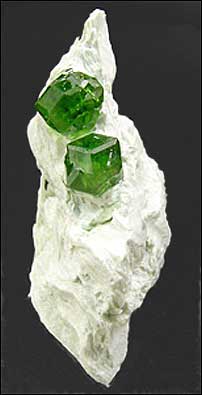
Fabre Minerals specimen and photo.
The second discovery occurred recently (to quote Jordi) “in Ambanja, Department of Diana, Madagascar, and in an unusual site, a kind of platform washed by the sea and about 9 meters deep beneath seaweed and organic matter.” This is rather hard to picture, but at least I can help you picture the specimens, which indeed seem to revel in photogenicity: the thumbnail shown here features two intergrown crystals of demantoid which are lustrous, sharp, and gemmy pale green. On Jordi’s six matrix specimens from Madagascar, which are between 2.5 and 5 cm across, the maximum size of the demantoid crystals is 1 cm, although, he says, some specimens with crystals to 2 cm have also emerged. The crystals rest on an unidentified white material presumably dug from the ledge somewhere beneath all that seaweed.
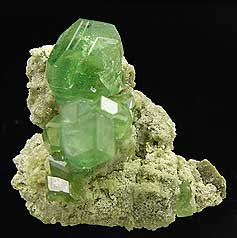
Fabre Minerals specimen and photo.
Now let us make the acquaintance of the unusual group of Polish mineral enthusiasts which calls itself the Spirifer Geological Society. The Spirifer group is a non-profit, self-supporting association of geologists and mineralogists which, from its headquarters in Warsaw, mounts expeditions to mineralogically interesting places worldwide; its members bring back specimens, stage educational expositions, write articles for journals, and even produce their own publication for mineral collectors, called Otoczak. There is also a fairly new, and very handsome, Spirifer website (www.spiriferminerals.com), where one may acquire specimens either through auction bidding or by direct retail purchase, thus helping to fund future Spirifer projects. In 2008 the club had an exceptionally busy year, sending parties out to Madagascar, Mongolia, Russia, Tajikistan, India, China, Morocco and several places in eastern Europe—so it’s no wonder that there are many intriguing minerals to be seen on the site right now. To my mind the most intriguing are a few miniature-size specimens showing excellent crystals of the rare silver antimonide dyscrasite (Ag3Sb). The specimens have come, presumably sometime within the past year, from what the Spirifer website calls a “new find” at Bouismas, in the Bou Azzer mining district, Morocco. Consult the map of the Bou Azzer district in our special Bou Azzer issue (September-October 2007), and you will see that Bouismas is a still-active mine almost in the district’s center. Consult the list of known Bou Azzer species in the same issue, however, and you will not find dyscrasite—this is a “new find” indeed, and a promising one. These are not the world’s finest dyscrasite specimens; that honor probably belongs to some of the specimens collected during the period 1984-1986 on a deep level of Mine #21, Pribram, Bohemia, Czech Republic, just before ore mining at this ancient classic locality finally ceased. The Pribram dyscrasite specimens show long, spiky, metallic tin-white or pale gray crystals exposed by dissolving away enclosing (gray) native arsenic or (white) calcite, and the new specimens from Bouismas show similar spiky to lathlike, brightly metallic white dyscrasite crystals to several centimeters long, in subparallel groups half-embedded in the white calcite that once completely enclosed them. Some of the Moroccan specimens also show bundles of splintery pale green crystals of actinolite which likewise had been enclosed in calcite. My e-mail inquiries requesting details about this occurrence have gone unanswered, and so right now I am just as curious about it as you are. I’ll try, of course, to learn more, but meanwhile, check out the picture (below) showing what looks to me like the best of the dyscrasite/actinolite specimens from Morocco now being offered by the Spirifer group.
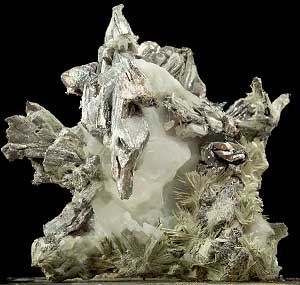
Spirifer Minerals specimen and photo.
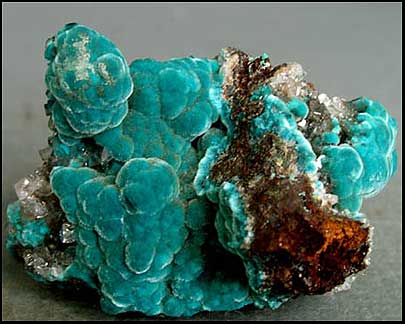
The Crystal Mine specimen and photo.
In the last online report I hailed the diverse new specimen material now coming onto the market from the Ojuela mine, Mapimí, Durango, Mexico. Ore mining at this huge polymetallic deposit ran sporadically from 1598 to the mid-1940’s (see our Ojuela special issue, September-October 2003), but recent renewed mining by the Peñoles Company has brought one of Mark Twain’s best lines to mind: “The reports of my death have been greatly exaggerated.” Good examples of the new Ojuela mine wulfenite are to be seen in many places around cyberspace, and less commonly one can spot recently collected calcite, aurichalcite, malachite, austinite and copper-rich adamite. Isaias Casanova of IC Minerals (www.icminerals.com) has some bright crystal clusters of transparent purple to lavender, fluorescent fluorite just found in the Ojuela mine; and very pretty specimens of reniform baby-blue rosasite lining cavities in the typical Ojuela gossan may be seen on Jack Crowley’s The Crystal Mine site (www.crystal-mine.com), among other places. And then there is the monstrously rare hydrous copper chloride claringbullite, not listed among the Ojuela species in the 2003 special issue but found, reportedly as only three or four specimens, in March 2009 in the San Juan Poniente lugar (collecting site) of the Ojuela mine. The best one of these specimens now belongs to rare-species specialist Tom Loomis, and is pictured on his Dakota Matrix Minerals website (www.dakotamatrix.com); Tom has let me swipe the picture to show you as well. A lustrous, platy, deep blue partial crystal of claringbullite measuring a remarkable 3.5 cm across rests atop a piece of massive red cuprite; probably present as well are small blebs and microcrystals of atacamite and paramelaconite. Not since August 1986, when Richard Graeme and his two sons found claringbullite in a similar mineral suite which hid out in cavities in cuprite boulders in the old Southwest mine, Bisbee, Arizona, has this exotic species been seen in notable specimens—and, even so, in the Bisbee pieces the claringbullite comes only as microcrystals lining small vugs.
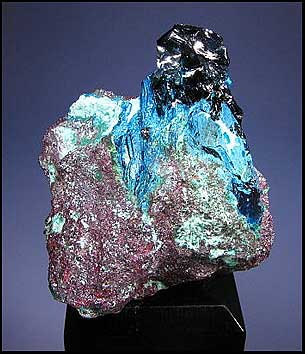
Durango, Mexico. Dakota Matrix specimen and photo.
To return for a moment to The Crystal Mine (www.crystal-mine.com), I heartily recommend this site, run by longtime field collector Jack Crowley of Reno, Nevada, for its mixed offerings of one-of-a-kinders which Jack himself has dug on long desert days of heat, spearing sunlight, and barely cooled-off umber shadows. Right now, for example, Jack is showing off three specimens of epidote—not from Nevada’s well-known Julie claim near Hawthorne, but from three different small, isolated occurrences. These localities are not mentioned in Castor and Ferdock’s Minerals of Nevada (2004) but are productive, anyway, of pretty things like the epidote specimen shown here, an 8-cm jackstraw cluster of lustrous, bladed, pistachio-green crystals to 4 cm. About 5 years ago, Jack writes, he extracted this specimen from a pocket the size and shape of a football in Paymaster Canyon, Mineral County, Nevada. Jack’s “new arrivals” section also offers mainstream merchandise like Chinese pyromorphite and azurite, crocoite from Tasmania, chalcopyrite from Peru, arsenopyrite from Panasqueira, and the nice new Ojuela items mentioned above, but it is his field-collected pieces which surprise and enlighten the shopper who visits this site.
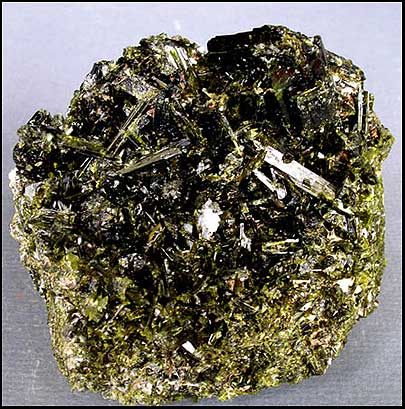
The Crystal Mine specimen and photo.
In my report on the 2009 Tucson Show (in the May-June 2009 issue) I briefly mentioned the superb, mostly thumbnail-size specimens of spinel-law-twinned fluorite which were found at Naica, Chihuahua, Mexico just a week before the Tucson Show, and a few of which made it north just in time for a couple of dealers to offer them at the Inn Suites. However, there was no room in the show report for a picture of one of these gorgeous little specimens. Well, fluorite-fancying dealer Kiyoshi Kiikuni of Key’s Minerals (www.keysminerals.com) has bought a small handful of the new Naica fluorites and is showing them now on his site—so here, after all (and by way of Tokyo), is a photograph. The fluorite is highly lustrous, pale blue, and gemmy, with the spinel-law twins in discrete clusters and perched up on small bits of matrix; most of the twins are considerably flattened along an axis perpendicular to the twin plane. Like the dealers who handled these items at the Tucson Show, Kiyoshi asks prices for them which for fluorite thumbnails are pretty serious (e.g. $380 for the one in the picture), but the specimens are so beautiful and classy that they will probably sell fast anyway, just as they did in Tucson.
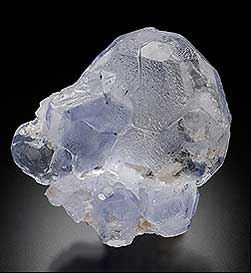
Key’s Minerals specimen and photo.
Also to be seen on the Key’s Minerals site is a photo of one of the new phosphophyllite specimens from the Infiernillos mine, Canutillos, Colavi district, Saavedra Province, Potosí Department, Bolivia. These were also mentioned in my Tucson Show report but not pictured, so here (below) is what they look like: certainly not beautiful, in fact not remotely competitive with the gemmy old-timers from Cerro Rico de Potosí, but representing a new phosphophyllite occurrence nevertheless, and thus highly worthy of note.

Bolivia. Key’s Minerals specimen and photo.
The Tamarack Mineral Company of upstate Michigan has a website (www.tamarackminerals.com) where one can find many good things from the famous Michigan “copper country,” including some very impressive copper specimens from the recent underwater discovery in Eagle Harbor, Keweenaw County: an occurrence which has come to be called the “Laker Pocket.” (Yes, this was also mentioned in my Tucson Show report, but with no specimen pictured.) Collecting from the vein which crops out underwater in Eagle Harbor dates to August 2008, when scuba-diving Bob Barron took out roughly 500 specimens, miniature to large-cabinet size. The copper crystals are sharp and reach 1 cm, but what’s most distinctive about these specimens is their varying patinas: some areas of the crystal clusters have the hue of a somewhat worn penny; others are dull black (tenorite), while still others are brick-red (cuprite); green malachite spots are ubiquitous. On the Tamarack site you can find quite a good selection of specimens along the lines of the crisp miniature pictured here.
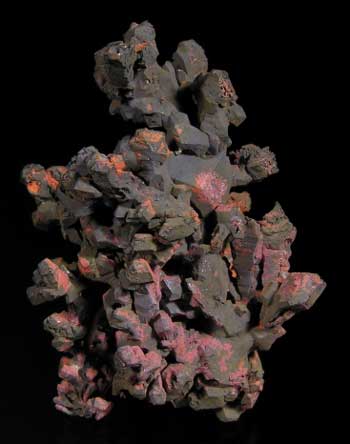
Tamarack Minerals specimen and photo.
As usual, Rob Lavinsky of The Arkenstone (www.irocks.com has picked up some new items which (as usual) he is excited about, and which he is marketing on his site with the help of drop-dead-beautiful pictures taken by expert photographer Joe Budd. First, the pretty things: a new prospect near the old workings of the ACF mine, Mibladen, Morocco, has yielded about 70 new vanadinite specimens, from loose thumbnail and small miniature-size groups to lush, sprawling matrix pieces of large-cabinet size with short-prismatic, screamingly red to orange to red-brown vanadinite crystals to 2 cm studded all over them. Certainly, by now, we’re used to seeing dramatic vanadinite specimens from Mibladen, but every once in awhile there’s a new lot so dazzling that we forget to worry about getting jaded. Some of the crystals in this new lot are color-zoned in red and orange and show a “sandwich” effect (with the orange in the middle), and some have thin, tan-colored coatings on their prism faces. Some of the crystals are compound and complexly stepped, so that when they pile up in parallel groups the suggestion is of slowly turning and meshing mechanical gears. These vanadinite specimens can impress anyone, including your most fuddled, non-mineralogical great-great aunt; below, a small and a large example are pictured.
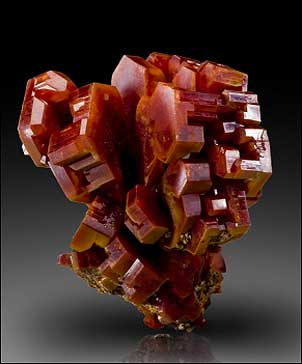
The Arkenstone specimen; Joe Budd photo.
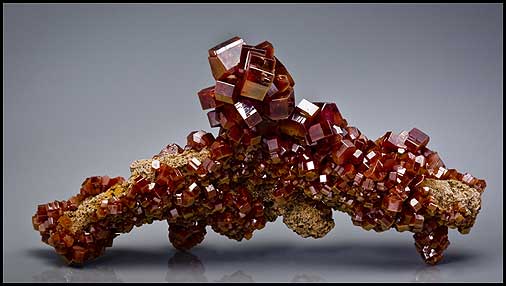
The Arkenstone specimen; Joe Budd photo.
For another new item on Rob’s The Arkenstone site the key concept is rarity, not (not at all) aesthetic beauty. In 1970-1971, members of an Italian company called SOMIREN, on a search for uranium in central Africa, found some remarkable crystals of the rare-earth-element and uranium oxide species davidite at a near-surface site along the Luiswishi River, South East Solwezi, Zambia. The davidite crystals were sent to Italy “for study” but ended up, forgotten, in a storage drawer at a university; they have never been marketed until now. Equant and fairly sharp-edged, the crystals range between 2.3 and 15.5 cm; they are buff-brown to dull black, and some are lightly spotted and filmed with iron oxides. Rare-species specialists ought to find these crystals highly desirable, although Rob cannot say whether they are davidite-(Ce), davidite-(La) or davidite-(Y), the three possibilities given in Fleischer’s Glossary of Mineral Species (2008).
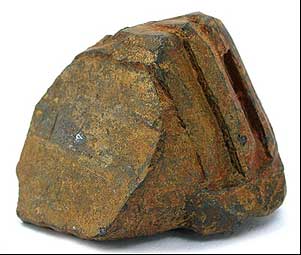
The Arkenstone specimen; Joe Budd photo.
Rick Kennedy of Earth’s Treasures (www.earthstreas.com) has lately been developing a new pegmatite in San Bernardino County, California: his excavation is called the California Blue mine, and the main object of the hunt so far is gem-quality crystals of aquamarine beryl. Rick brought a few California Blue mine specimens to the Costa Mesa Show in mid-May, and more are now being shown on the Earth’s Treasures website and on John Veevaert’s Trinity Minerals website (www.trinityminerals.com). This very new project has so far produced only so-so aquamarine crystals, all of them very pale blue and most of them showing some etching; the topaz crystals, also pale blue, are rarely gemmy. But pictured here is a very aesthetic California Blue mine smoky quartz specimen which is, Rick says, the best quartz specimen found so far in the mine. This notice, then, is a heads-up: we may or may not be seeing the earliest stage in the development of another great pegmatite occurrence in California.
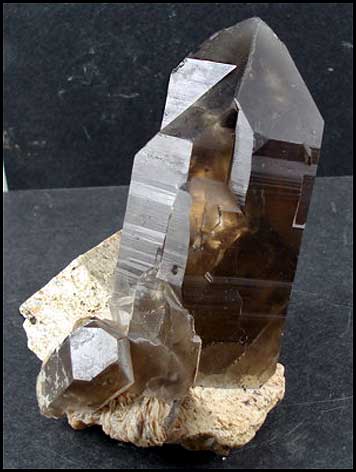
California. Earth’s Treasures specimen and photo.
Time now for a quick look around some mineralogical sights (and sites) of Old Europe. Go to the website called Minservice (www.minservice.com) and thence to the Ferrero’s Minerals, and you will see some fine specimens from a collection of Italian classics acquired recently by longtime collectors and part-time dealers Fabrizio and Luca Ferrero, of Torino. The best of these specimens are cabinet-size matrix chunks with exposed vugs of crystals, as for example the anglesite from Monteponi, Iglesias, Sardinia, shown here. From the old Monteponi lead mines there are also fine specimens of cerussite and phosgenite; there is excellent ferrierite from Monte Olladri, Sardinia; rhodonite and copper from Val Graveglia (see our September-October 2001 issue); haüyne from Sacrofano, Latium (see the last online report); babingtonite from Baveno, Piedmont; petalite and ilvaite from the Isle of Elba; surprisingly good chalcophyllite from an old mine in Sardinia…and many more. Mixed in with the Italian goodies are, among others, a gorgeous French specimen of uranophane, a big leucite from the Czech Republic, eudialyte and lorenzenite from Russia’s Kola Peninsula, sainfeldite from Bou Azzer, a razor-sharp Chessy cuprite…suffice it to say that I browsed on this site all through what I’d thought would be my lunch hour.
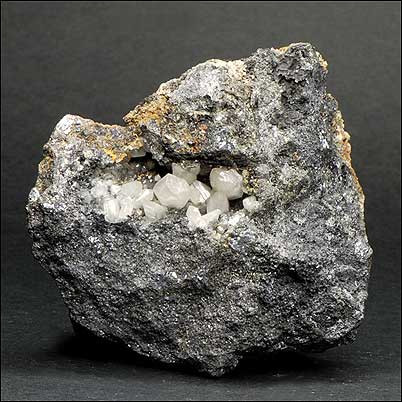
Ferrero’s Minerals specimen and photo.
A new European website is that of Watzl Minerals (www.watzlminerals.com), run by Anton and Rudolf Watzl, two young Strahlers from Linz, Austria. This site has three galleries, “Alpine,” “International” and “African,” and on all three the mineral specimens bespeak good taste on the part of the Watzl brothers but the most interesting gallery by far is “Alpine,” which bespeaks also their personal collecting—strahling—skills. I would give a lot to have had the experience, just once, of digging out the petite, lovely amethyst scepter specimens for sale here; the Watzls dug them at the well known collecting site, intermittently productive for decades, called Mörchnerkar, Zillertal, Tyrol, Austria. Other Alpine specimens in this gallery include a 6.6-cm, pale smoky quartz gwindel from the Göscheneralp, Uri, Switzerland; platy, rutile-studded hematite crystals from Cavradi, Switzerland and hematite “iron roses” from several places; a wonderful smoky quartz crystal cluster from Val Giuv, Graubünden, Switzerland; a yellow, part-gemmy apatite from Wildenkar, Habachtal, Salzburg, Austria; grossular and demantoid specimens from northern Italy; a fine fluorite from Böckstein, Bad Gastein, Salzburg, Austria; and two fantastic old epidote specimens from the great cleft at Untersulzbachtal, Salzburg, Austria. Alpine minerals can be addictive, and Watzl Minerals seems a good place to develop and feed any beauty-requiring habit of this kind which one might develop.
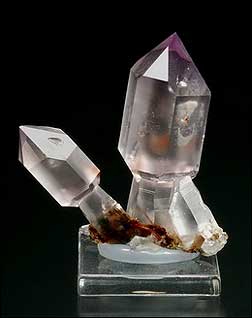
Watzl Minerals specimen and photo.
The dealership called Well-Arranged Molecules (www.wellarrangedmolecules.com) has a July update to its website which features 18 new Chinese wulfenite specimens, “toenail” to cabinet-size. The specimens are very fine, and look much like those from the remote locality in the Kuruktag Mountains, Xinjiang Uygur Autonomous Region, which have been trickling onto Western markets since late in 2006—see the article by Wilson and Origlieri in our “China II” issue (January-February 2007). However, the locality given by Well-Arranged Molecules is “Tuokexun (Toksun), Tulufan Prefecture, Xinjiang Uygur.” According to Mindat.org, Tuokexun is a uranium deposit in sandstone which does not number wulfenite among its known species—so we have here either a brand-new strike of major wulfenite specimens at Tuokexun, or simply a misattribution of specimens from the familiar (if vaguely defined) Kuruktag Mountains locality. Anyway, these new specimens are irregular clusters of lustrous, red-orange, thin-tabular wulfenite crystals, with white cerussite microcrystals solidly coating some of the wide basal wulfenite faces.
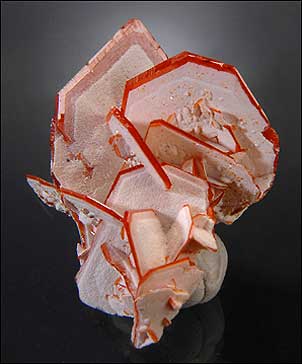
China. Well-Arranged Molecules specimen and photo.
Gill’s PDF Library
Joseph O. Gill has just sent out word that his newly completed (after several years’ hard work) electronic Gem and Mineral Research Library is ready to be given FREE to anyone who makes an appointment to have the Library copied onto a personal laptop or hard drive. The “gem” part of the Library, 5 GBs in size, contains more than 200 books on gemstones dating from 1652 to 2009, including classic texts by Robert Boyle, John Mawe, and George Frederick Kunz, and including all of the journal Gems & Gemology for the years 1934 to 1980. The mineral book collection, 3.9 GBs, contains about 160 books, from the 1556 first edition (in Latin) of Agricola’s De Re Metallica through Curtis P. Schuh’s Biobibliographical Archive, also seen on this website. I repeat, all this is free to anyone who requests it—and it’s still just the beginning of a larger project to put history’s immense accumulation of gemological and mineralogical texts in digital form for easy use by all. To ask general questions, contact Joe Gill at gilljoseph1949@yahoo.com. For technical details, or to inquire about an appointment, contact Marc Jobin at mj3inc@aol.com.
For questions about this column, please email Tom Moore.
